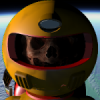Previously I have dealt with the problem by splitting the depth range in two and using the first part for near stuff and another for distant stuff. The boundary was floating, somewhere around 5km - quad-tree tiles up to certain level were using the distant part, and the more detailed tiles that by law of LOD are occurring nearer the camera used the other part.
Most of the time this worked. But in one case it failed miserably - when a more detailed tile appeared behind a less detailed one.
I was thinking about the ways to fix it, grumbling why we can't have a depth buffer with a better distribution, when it occurred to me that maybe we can.
Steve Baker's document explains common problems with depth buffers (Z-buffers). In short, the depth values are proportional to the reciprocal of Z. This gives amounts of precision near the camera but little off in the distance. Common method is then to move your near clip plane further away, which helps but also brings its own problems, mainly that .. the near clip plane is too far [rolleyes]
A much better Z-value distribution is a logarithmic one. It also plays nicely with LOD used in large scale terrain rendering.
Using the following equation to modify depth value after it's been transformed by the projection matrix:
z = log(C*z + 1) / log(C*Far + 1) * w; //DirectX with 0..1 depth rangez = (2*log(C*z + 1) / log(C*Far + 1) - 1) * w; //OpenGL with -1..1 depth rangeResolution at distance x, for given C and n bits of depth buffer resolution can be computed as
log(C*Far + 1)Res = ---------------- (2^n-1) * C/(C*x+1)So for example for a far plane at 10,000 km and 24-bit Z-buffer this gives the following resolutions:
1m 10m 100m 1km 10km 100km 1Mm 10Mm ------------------------------------------------------------C=1 1.9e-6 1.1e-5 9.7e-5 0.001 0.01 0.096 0.96 9.6 [m]C=0.001 0.0005 0.0005 0.0006 0.001 0.006 0.055 0.549 5.49 [m]Along with the better utilization of z-value space it also (almost) gets us rid of the near clip plane.
And here comes the result.

Looking into the nose while keeping eye on distant mountains ..

10 thousand kilometers, no near Z clipping and no Z-fighting! HOORAY!
More details
(at the request of y2kiah)The C basically changes the resolution near the camera; I used C=1 for the screenshots, having theoretical resolution 1.9e-6m. However, the resolution near the camera cannot be utilized fully as long as the geometry isn't finely tessellated too, because the depth is interpolated linearly and not logarithmically. On models such as the guy on the screenshots it is perfectly fine to put camera on his nose, but with models with long stripes with vertices few meters apart the bugs from the interpolation can be visible. We will be dealing with it by requiring certain minimum tessellation.
Also I think I've read somewhere that some forthcoming generation of hardware will support different modes of interpolation too.
So yes, modifying C changes the resolution near the camera, setting it to a value that gives the largest acceptable resolution may be desirable to achieve more linear distribution in the near range and thus minimizing the interpolation problem.
Near clip plane can be put arbitrarily 'near' but not zero because of the 1/w division. I have put it to 0.0001m. This is using standard perspective projection setup.
Negative Z artifact fix
Ysaneya suggested a fix for the artifacts occurring with thin or huge triangles when Z goes behind the camera, by writing the correct Z-value at the pixel shader level. This disables fast-Z mode but he found the performance hit to be negligible.







